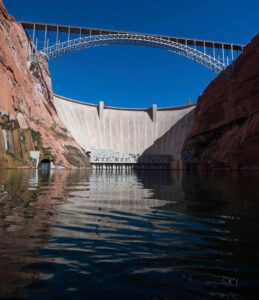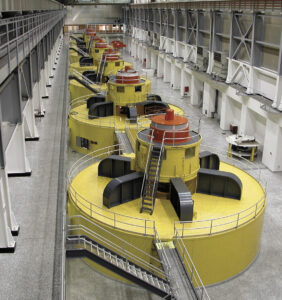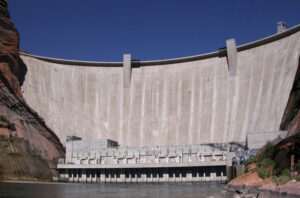The Colorado River Energy Distributors Association (CREDA) is a trade association that represents firm power customers of the hydroelectric facilities of the Bureau of Reclamation’s Colorado River Storage Project (CRSP). CREDA aims to protect and enhance the resources of the CRSP while also advocating for affordable and transparent power rates. Its efforts are carried out primarily at the federal level, where it advocates for legislation and provides input on regulatory matters. Leslie James has been executive director of CREDA for more than 20 years. In this interview, she tells Hydro Leader about the association’s work and current top issues.
Hydro Leader: Please tell us about your background and how you came to be in your current position.
Leslie James: I was born and raised in Phoenix, Arizona, and still live there. I am a fourth-generation Arizonan on both sides of my family. I went to college at Northern Arizona University in Flagstaff and graduated with a dual major in political science and paralegal studies.. My first job out of college was working as a file clerk for a law firm. In 1978, I started working for the Salt River Project (SRP) as a risk analyst. I had great opportunities there. I worked on the power side and in the contracts department; I didn’t have much of an opportunity to work on the water side. I managed the wholesale markets and contracts department at SRP until I left in 1998. During my tenure at SRP, I had the opportunity to represent SRP on the CREDA board of directors and served as CREDA board president from 1995 to 1996, so I got to know the organization while I was still at SRP. I have held the position of executive director of CREDA since 1998.
Hydro Leader: What are your responsibilities as executive director of CREDA?
Leslie James: I am CREDA’s only full-time paid staff member. My job is to manage all the organization’s business, federal affairs, and environmental issues and to represent the board in its mission of protecting and enhancing the resources of the CRSP.

Hydro Leader: Please tell us about CREDA as an organization.
Leslie James: CREDA was established in 1978 by a group of CRSP firm power customers. At that time, the CRSP’s costs were skyrocketing. There was a lot of transmission construction being done as CRSP units came online. Glen Canyon Dam in Arizona came online in 1963.
Other CRSP units include Flaming Gorge Dam in Utah and the Aspinall Unit, which comprises the Blue Mesa, Morrow Point, and Crystal generators in Colorado. The power generated by Reclamation is transmitted by the Western Area Power Administration (WAPA) to its wholesale customers.
Each of CREDA’s members is a nonprofit entity that is a firm electric service customer of WAPA. That general description covers quite a range of entities, including tribal utilities, state agencies, municipalities, cities, towns, and co‑ops. The one requirement to be a member of CREDA and to have a board seat is to have a CRSP contract with WAPA.
In my role as executive director, I work with a board with 24 voting members that meets every other month. There is also an executive committee of 6 members. My responsibility is to represent the CREDA membership in my work with WAPA and Reclamation, with the objective of keeping rates as low as possible and keeping CRSP resources available. I work with those agencies on rate case issues; environmental issues; operational issues; records of decision related to Glen Canyon Dam, Flaming Gorge, and the Aspinall Unit; and federal legislative initiatives that may affect the resources of the CRSP. Internal to CREDA, I am also responsible for developing an annual budget that is then approved by the board.
Hydro Leader: What is the history of CREDA?
Leslie James: CREDA was started back in 1978 by a handful of CRSP customers who noticed that their CRSP firm electric service rates were continually rising. That rise was being driven by the fact that CRSP power customers are responsible for repaying all the federal investment in the CRSP, plus interest, as well as paying for ongoing operations and maintenance costs. That includes all of Reclamation’s and WAPA’s costs. It also includes irrigation assistance beyond the ability of the irrigators to repay, although that piece is not interest bearing.
When the individual customers started seeing these rates increasing, they decided to form an organization that would give them a common voice and that could work with Reclamation, WAPA, and other federal agencies to keep rates as low as possible. It would also help them to collectively deal with the operational effects of the National Environmental Policy Act, the Endangered Species Act (ESA), and major species-recovery programs. CREDA was incorporated in 1978. It’s a 503(c)(6) nonprofit corporation. It was originally incorporated in the state of Colorado; since then, we’ve also incorporated in the state of Arizona, which is where our office is located.
Hydro Leader: What are your top issues?
Leslie James: It depends on the year, on the Congress, and on the agency’s priorities for the year. In 2020, WAPA just wrapped up a 5‑year rate case for the CRSP firm electric service rate. WAPA rates have to be approved by the Federal Energy Regulatory Commission (FERC). WAPA has a robust public process for dealing with rate changes, and in this case, the process started well over a year ago. Currently, the final rate has been approved by the administrator of WAPA and the U.S. Department of Energy and is awaiting approval by FERC. WAPA’s objective is to ensure the repayment of federal investments and obligations while keeping cost-based rates as low as possible consistent with sound business principles. That’s what FERC looks at in the rate filing.
Over the last 2 years, CREDA worked with WAPA to understand what would be included in the rate case and to work with it through the public process. After the Federal Register notice process and public process started, we developed and submitted comments on the rate brochure. We’re pretty pleased with where the rate is going this year; the final rate information was published in the Federal Register on August 21. The rate will take effect on October 1. That’s intended to be a 5‑year rate.
Hydro Leader: Please tell us about your work with Congress.
Leslie James: The intensity of our work with Congress varies year by year. We are always interested in watching energy and water development appropriations proceedings, even though CREDA differs from many of its sister organizations in being financed by a revolving fund rather than by direct appropriations. The Upper Colorado River Basin Fund was established by the CRSP Act of 1956 and is funded almost entirely by CRSP power revenues. That means that our involvement in the appropriations process is usually less intense that that of other water users and project power customers.
Our direct involvement in Congress has to do with things like the upper Colorado River and San Juan River endangered fish recovery programs, in which we are a partner. Up until now, the primary funding sources for those programs have been CRSP power revenues, and those revenues have also funded $17 million in capital funds for those programs. Looking toward the future, it’s pretty clear that the funding model needs to change—power revenues can’t continue to be the only source of sustainable funding for those programs. We’ll be working with the other partners over the next year or two about sharing the funding and extending the authorization for that program. Right now, its authorization goes through 2023. We’ll be working with the states, our environmental partners, Reclamation, and WAPA on that process.
In general, we’re more involved with authorization matters than with appropriations. We get involved with any legislation that has the potential to affect the operations of CRSP facilities or cost sharing.
My first opportunity to testify before Congress occurred when I’d only been on the job for about a week. That testimony was on the Dutch John privatization bill, which transferred the town of Dutch John, Utah, from federal to private ownership. The negotiation leading up to the federal

legislation provided for a 10‑ or 15‑year subsidy from power revenues to the town. We testified to ensure that there was an understanding that the power customers had an interest in what was going on, given that we would have a 15‑year obligation to subsidize the town following title transfer. We’ve had a long and varied history on title transfer issues. Generally, CREDA doesn’t have a dog in those fights unless the facilities in question have a hydropower component, have been funded by power revenues, or have an allocation of project use power.
We’ve also testified on transparency bills. I think one of the first was a bill introduced by Congresswoman Cathy McMorris Rogers a few years ago to ensure that the costs of environmental compliance are transparent to the entities that have to pay them. There have been various ESA transparency bills as well. Before Senator Jeff Flake left Congress, he introduced a WAPA transparency bill to ensure that WAPA’s expenditures are available and transparent to its customers. In that bill, there was also a provision to ensure that the Upper Colorado River Basin Fund is not considered an unobligated balance of WAPA. That fund is clearly earmarked by the CRSP Act for specific purposes, so we do not want it to be lumped in with the rest of WAPA’s unobligated balances.
Hydro Leader: What advice do you have for other river systems with hydropower components?
Leslie James: One of the things I learned pretty quickly was that DC representation is crucial. For my first 20 years at CREDA, our DC-based representative was Deborah Sliz; there is no one who can replicate Deborah. Since then, I have learned quickly that it’s important for the members of these trade organizations to establish relationships with their congressional delegations, both at home and in DC. I know it’s costly and challenging to send people to DC, but I have heard from many staffers that is important for them to hear from the people on the ground.
I try hard to establish relationships with like-minded and sometimes not-so-like-minded trade organizations. You never know when an issue may arise on which you can help support another organization or on which your organization may need support in a public process. For example, when the last Glen Canyon environmental impact statement process was underway, we believed that it had the potential to negatively affect the hydropower resource of Glen Canyon Dam. The relationships that we’ve cultivated over many years allowed us to get comment letters from the American Public Power Association, the National Hydropower Association, the National Rural Electric Cooperative Association, and the National Water Resources Association. To get all those entities to support a common message on the public record was an achievement.

It is important to make an effort to get to know and understand where a lot of these organizations are coming from and to identify common themes to work together on. We work in a six-state region, but we don’t deal with state legislation, only federal, which is why long-distance relationships come in handy. It is also important to make sure that your members are making connections with their federal delegations. As an association, you should also introduce your members to members of other organizations.
Hydro Leader: What are your thoughts on the Colorado River Water Users Association’s yearly meeting?
Leslie James: It’s one of the best opportunities to talk with people and reestablish those connections I was discussing. I’ve had the opportunity to speak at the meeting twice, which I appreciated. It is primarily a water-oriented organization, but I think there has been an increasing recognition that water and power are joined at the hip. There are more commonalities than differences. I really hope that these association meetings will always continue, because a lot of work gets done there.
Leslie James is the executive director of the Colorado River Energy Distributors Association. She can be contacted at creda@creda.cc. For more about CREDA, visit www.credanet.org.

